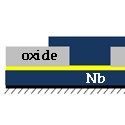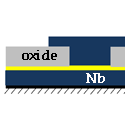Spin-triplet supercurrents in a magnetic Josephson junction
If a conventional superconductor is brought into contact with a normal metal, superconducting pair correlations penetrate into the metal, a process known as the superconducting proximity effect. If the metal is instead ferromagnetic, the penetration of superconducting pairs, which typically form spin-singlets, is much shorter. Theoretically, however, if the ferromagnet is inhomogeneous, then spin-triplet electron pairs would appear at the superconductor-ferromagnet interface that could penetrate further into the ferromagnet.
In a paper appearing in Physical Review Letters, Trupti Khaire, Mazin Khasawneh, William Pratt, Jr., and Norman Birge of Michigan State University in the US have constructed an ingenious superconductor-ferromagnet-superconductor Josephson junction to look for such a spin-triplet current. Their trick is to construct the ferromagnetic layer from a multilayered sandwich of weak and strong transition-metal magnetic layers. The complicated magnetic layer is necessary to create a noncollinear magnetic environment for the Cooper pairs from the superconductor, which is required to generate the spin-triplet pairs. The layer also suppresses the spin-singlet supercurrent, thereby making the spin-triplet current easier to detect. Khaire et al. find a spin-triplet supercurrent that depends on magnetic layer thickness, and persists for at least several tens of nanometers. – Daniel Ucko





